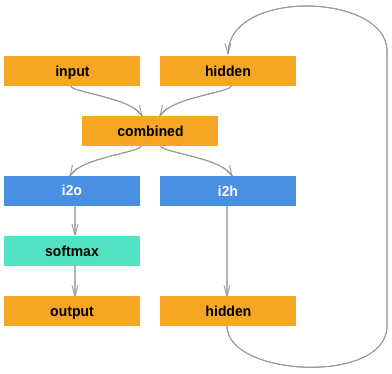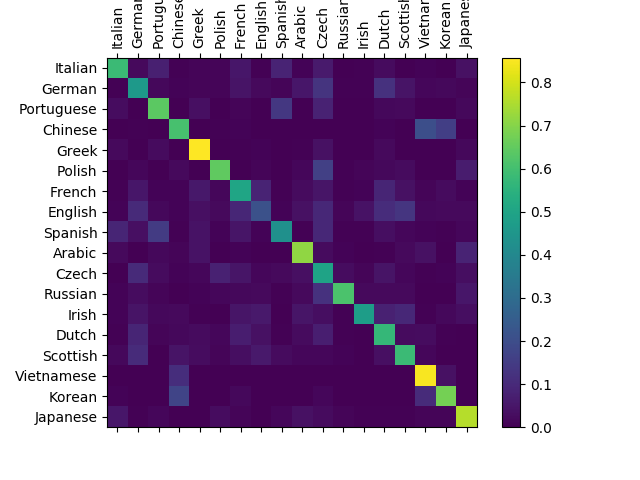使用字符级别特征的RNN网络进行名字分类
译者:hhxx2015
校对者:hijkzzz
作者: Sean Robertson
我们将构建和训练字符级RNN来对单词进行分类。 字符级RNN将单词作为一系列字符读取,在每一步输出预测和“隐藏状态”,将其先前的隐藏状态输入至下一时刻。 我们将最终时刻输出作为预测结果,即表示该词属于哪个类。
具体来说,我们将在18种语言构成的几千个名字的数据集上训练模型,根据一个名字的拼写预测它是哪种语言的名字:
$ python predict.py Hinton(-0.47) Scottish(-1.52) English(-3.57) Irish$ python predict.py Schmidhuber(-0.19) German(-2.48) Czech(-2.68) Dutch
推荐阅读:
我默认你已经安装好了PyTorch,熟悉Python语言,理解“张量”的概念:
- https://pytorch.org/ PyTorch安装指南
- Deep Learning with PyTorch: A 60 Minute Blitz PyTorch入门
- Learning PyTorch with Examples 一些PyTorch的例子
- PyTorch for Former Torch Users Lua Torch 用户参考
事先学习并了解RNN的工作原理对理解这个例子十分有帮助:
- The Unreasonable Effectiveness of Recurrent Neural Networks 展示了一些现实生活中的例子
- Understanding LSTM Networks 是关于LSTM的,但也提供有关RNN的一般信息
准备数据
点击这里下载数据 并将其解压到当前文件夹。
在”data/names”文件夹下是名称为”[language].txt”的18个文本文件。每个文件的每一行都有一个名字,它们几乎都是罗马化的文本(但是我们仍需要将其从Unicode转换为ASCII编码)
我们最终会得到一个语言对应名字列表的字典,{language: [names ...]}
通用变量“category”和“line”(例子中的语言和名字单词)用于以后的可扩展性。
from __future__ import unicode_literals, print_function, divisionfrom io import openimport globimport osdef findFiles(path): return glob.glob(path)print(findFiles('data/names/*.txt'))import unicodedataimport stringall_letters = string.ascii_letters + " .,;'"n_letters = len(all_letters)# Turn a Unicode string to plain ASCII, thanks to https://stackoverflow.com/a/518232/2809427def unicodeToAscii(s):return ''.join(c for c in unicodedata.normalize('NFD', s)if unicodedata.category(c) != 'Mn'and c in all_letters)print(unicodeToAscii('Ślusàrski'))# Build the category_lines dictionary, a list of names per languagecategory_lines = {}all_categories = []# Read a file and split into linesdef readLines(filename):lines = open(filename, encoding='utf-8').read().strip().split('\n')return [unicodeToAscii(line) for line in lines]for filename in findFiles('data/names/*.txt'):category = os.path.splitext(os.path.basename(filename))[0]all_categories.append(category)lines = readLines(filename)category_lines[category] = linesn_categories = len(all_categories)
输出:
['data/names/Italian.txt', 'data/names/German.txt', 'data/names/Portuguese.txt', 'data/names/Chinese.txt', 'data/names/Greek.txt', 'data/names/Polish.txt', 'data/names/French.txt', 'data/names/English.txt', 'data/names/Spanish.txt', 'data/names/Arabic.txt', 'data/names/Czech.txt', 'data/names/Russian.txt', 'data/names/Irish.txt', 'data/names/Dutch.txt', 'data/names/Scottish.txt', 'data/names/Vietnamese.txt', 'data/names/Korean.txt', 'data/names/Japanese.txt']Slusarski
现在我们有了category_lines,一个字典变量存储每一种语言及其对应的每一行文本(名字)列表的映射关系。
变量all_categories是全部语言种类的列表,
变量n_categories 是语言种类的数量,后续会使用
print(category_lines['Italian'][:5])
输出:
['Abandonato', 'Abatangelo', 'Abatantuono', 'Abate', 'Abategiovanni']
单词转化为张量
现在我们已经加载了所有的名字,我们需要将它们转换为张量来使用它们。
我们使用大小为<1 x n_letters>的“one-hot 向量”表示一个字母。
一个one-hot向量所有位置都填充为0,并在其表示的字母的位置表示为1,例如"b" = <0 1 0 0 0 ...>.(字母b的编号是2,第二个位置是1,其他位置是0)
我们使用一个<line_length x 1 x n_letters>的2D矩阵表示一个单词
额外的1维是batch的维度,PyTorch默认所有的数据都是成batch处理的。我们这里只设置了batch的大小为1。
import torch# 从所有的字母中得到某个letter的索引编号, 例如 "a" = 0def letterToIndex(letter):return all_letters.find(letter)# Just for demonstration, turn a letter into a <1 x n_letters> Tensordef letterToTensor(letter):tensor = torch.zeros(1, n_letters)tensor[0][letterToIndex(letter)] = 1return tensor# Turn a line into a <line_length x 1 x n_letters>,# or an array of one-hot letter vectorsdef lineToTensor(line):tensor = torch.zeros(len(line), 1, n_letters)for li, letter in enumerate(line):tensor[li][0][letterToIndex(letter)] = 1return tensorprint(letterToTensor('J'))print(lineToTensor('Jones').size())
输出:
tensor([[0., 0., 0., 0., 0., 0., 0., 0., 0., 0., 0., 0., 0., 0., 0., 0., 0., 0.,0., 0., 0., 0., 0., 0., 0., 0., 0., 0., 0., 0., 0., 0., 0., 0., 0., 1.,0., 0., 0., 0., 0., 0., 0., 0., 0., 0., 0., 0., 0., 0., 0., 0., 0., 0.,0., 0., 0.]])torch.Size([5, 1, 57])
构造神经网络
在autograd之前,要在Torch中构建一个可以复制之前时刻层参数的循环神经网络。
layer的隐藏状态和梯度将交给计算图自己处理。
这意味着你可以像实现的常规的 feed-forward 层一样,以很纯粹的方式实现RNN。
这个RNN组件 (几乎是从这里复制的 the PyTorch for Torch users tutorial) 仅使用两层 linear 层对输入和隐藏层做处理,
在最后添加一层 LogSoftmax 层预测最终输出。

import torch.nn as nnclass RNN(nn.Module):def __init__(self, input_size, hidden_size, output_size):super(RNN, self).__init__()self.hidden_size = hidden_sizeself.i2h = nn.Linear(input_size + hidden_size, hidden_size)self.i2o = nn.Linear(input_size + hidden_size, output_size)self.softmax = nn.LogSoftmax(dim=1)def forward(self, input, hidden):combined = torch.cat((input, hidden), 1)hidden = self.i2h(combined)output = self.i2o(combined)output = self.softmax(output)return output, hiddendef initHidden(self):return torch.zeros(1, self.hidden_size)n_hidden = 128rnn = RNN(n_letters, n_hidden, n_categories)
要运行此网络的一个步骤,我们需要传递一个输入(在我们的例子中,是当前字母的Tensor)和一个先前隐藏的状态(我们首先将其初始化为零)。
我们将返回输出(每种语言的概率)和下一个隐藏状态(为我们下一步保留使用)。
input = letterToTensor('A')hidden =torch.zeros(1, n_hidden)output, next_hidden = rnn(input, hidden)
为了提高效率,我们不希望为每一步都创建一个新的Tensor,因此我们将使用lineToTensor函数而不是letterToTensor函数,并使用切片方法。
这一步可以通过预先计算批量的张量进一步优化。
input = lineToTensor('Albert')hidden = torch.zeros(1, n_hidden)output, next_hidden = rnn(input[0], hidden)print(output)
输出:
tensor([[-2.8857, -2.9005, -2.8386, -2.9397, -2.8594, -2.8785, -2.9361, -2.8270,-2.9602, -2.8583, -2.9244, -2.9112, -2.8545, -2.8715, -2.8328, -2.8233,-2.9685, -2.9780]], grad_fn=<LogSoftmaxBackward>)
可以看到输出是一个<1 x n_categories>的张量,其中每一条代表这个单词属于某一类的可能性(越高可能性越大)
训练
训练前的准备
进行训练步骤之前我们需要构建一些辅助函数。
第一个是当我们知道输出结果对应每种类别的可能性时,解析神经网络的输出。
我们可以使用 Tensor.topk函数得到最大值在结果中的位置索引
def categoryFromOutput(output):top_n, top_i = output.topk(1)category_i = top_i[0].item()return all_categories[category_i], category_iprint(categoryFromOutput(output))
输出:
('Vietnamese', 15)
我们还需要一种快速获取训练示例(得到一个名字及其所属的语言类别)的方法:
import randomdef randomChoice(l):return l[random.randint(0, len(l) - 1)]def randomTrainingExample():category = randomChoice(all_categories)line = randomChoice(category_lines[category])category_tensor = torch.tensor([all_categories.index(category)], dtype=torch.long)line_tensor = lineToTensor(line)return category, line, category_tensor, line_tensorfor i in range(10):category, line, category_tensor, line_tensor = randomTrainingExample()print('category =', category, '/ line =', line)
输出:
category = Russian / line = Minkincategory = French / line = Massoncategory = German / line = Hasekcategory = Dutch / line = Kloetencategory = Scottish / line = Allancategory = Italian / line = Agostinicategory = Japanese / line = Fumihikocategory = Polish / line = Gajoscategory = Scottish / line = Duncancategory = Arabic / line = Gerges
训练神经网络
现在,训练过程只需要向神经网络输入大量的数据,让它做出预测,并将对错反馈给它。
nn.LogSoftmax作为最后一层layer时,nn.NLLLoss作为损失函数是合适的。
criterion = nn.NLLLoss()
训练过程的每次循环将会发生:
- 构建输入和目标张量
- 构建0初始化的隐藏状态
- 读入每一个字母
- 将当前隐藏状态传递给下一字母
- 比较最终结果和目标
- 反向传播
- 返回结果和损失
learning_rate = 0.005 # If you set this too high, it might explode. If too low, it might not learndef train(category_tensor, line_tensor):hidden = rnn.initHidden()rnn.zero_grad()for i in range(line_tensor.size()[0]):output, hidden = rnn(line_tensor[i], hidden)loss = criterion(output, category_tensor)loss.backward()# Add parameters' gradients to their values, multiplied by learning ratefor p in rnn.parameters():p.data.add_(-learning_rate, p.grad.data)return output, loss.item()
现在我们只需要准备一些例子来运行程序。
由于train函数同时返回输出和损失,我们可以打印其输出结果并跟踪其损失画图。
由于有1000个示例,我们每print_every次打印样例,并求平均损失。
import timeimport mathn_iters = 100000print_every = 5000plot_every = 1000# Keep track of losses for plottingcurrent_loss = 0all_losses = []def timeSince(since):now = time.time()s = now - sincem = math.floor(s / 60)s -= m * 60return '%dm %ds' % (m, s)start = time.time()for iter in range(1, n_iters + 1):category, line, category_tensor, line_tensor = randomTrainingExample()output, loss = train(category_tensor, line_tensor)current_loss += loss# Print iter number, loss, name and guessif iter % print_every == 0:guess, guess_i = categoryFromOutput(output)correct = '✓' if guess == category else '✗ (%s)' % categoryprint('%d %d%% (%s) %.4f %s / %s %s' % (iter, iter / n_iters * 100, timeSince(start), loss, line, guess, correct))# Add current loss avg to list of lossesif iter % plot_every == 0:all_losses.append(current_loss / plot_every)current_loss = 0
输出:
5000 5% (0m 11s) 2.0318 Jaeger / German ✓10000 10% (0m 18s) 2.1296 Sokolofsky / Russian ✗ (Polish)15000 15% (0m 26s) 1.2620 Jo / Korean ✓20000 20% (0m 34s) 1.9295 Livson / Scottish ✗ (Russian)25000 25% (0m 41s) 1.2325 Fortier / French ✓30000 30% (0m 49s) 2.5714 Purdes / Dutch ✗ (Czech)35000 35% (0m 56s) 2.3312 Bayer / Arabic ✗ (German)40000 40% (1m 4s) 2.3792 Mitchell / Dutch ✗ (Scottish)45000 45% (1m 12s) 1.3536 Maes / Dutch ✓50000 50% (1m 20s) 2.6095 Sai / Chinese ✗ (Vietnamese)55000 55% (1m 28s) 0.5883 Cheung / Chinese ✓60000 60% (1m 35s) 1.5788 William / Irish ✓65000 65% (1m 43s) 2.5809 Mulder / Scottish ✗ (Dutch)70000 70% (1m 51s) 1.3440 Bruce / German ✗ (Scottish)75000 75% (1m 58s) 1.1839 Romero / Italian ✗ (Spanish)80000 80% (2m 6s) 2.6453 Reyes / Portuguese ✗ (Spanish)85000 85% (2m 14s) 0.0290 Mcmillan / Scottish ✓90000 90% (2m 22s) 0.7337 Riagan / Irish ✓95000 95% (2m 30s) 2.6208 Maneates / Dutch ✗ (Greek)100000 100% (2m 37s) 0.5170 Szwarc / Polish ✓
画出结果
从all_losses得到历史损失记录,反映了神经网络的学习情况:
import matplotlib.pyplot as pltimport matplotlib.ticker as tickerplt.figure()plt.plot(all_losses)

评价结果
为了了解网络在不同类别上的表现,我们将创建一个混淆矩阵,显示每种语言(行)和神经网络将其预测为哪种语言(列)。
为了计算混淆矩阵,使用evaluate()函数处理了一批数据,evaluate()函数与去掉反向传播的train()函数大体相同。
# Keep track of correct guesses in a confusion matrixconfusion = torch.zeros(n_categories, n_categories)n_confusion = 10000# Just return an output given a linedef evaluate(line_tensor):hidden = rnn.initHidden()for i in range(line_tensor.size()[0]):output, hidden = rnn(line_tensor[i], hidden)return output# Go through a bunch of examples and record which are correctly guessedfor i in range(n_confusion):category, line, category_tensor, line_tensor = randomTrainingExample()output = evaluate(line_tensor)guess, guess_i = categoryFromOutput(output)category_i = all_categories.index(category)confusion[category_i][guess_i] += 1# Normalize by dividing every row by its sumfor i in range(n_categories):confusion[i] = confusion[i] / confusion[i].sum()# Set up plotfig = plt.figure()ax = fig.add_subplot(111)cax = ax.matshow(confusion.numpy())fig.colorbar(cax)# Set up axesax.set_xticklabels([''] + all_categories, rotation=90)ax.set_yticklabels([''] + all_categories)# Force label at every tickax.xaxis.set_major_locator(ticker.MultipleLocator(1))ax.yaxis.set_major_locator(ticker.MultipleLocator(1))# sphinx_gallery_thumbnail_number = 2plt.show()

你可以从主轴线以外挑出亮的点,显示模型预测错了哪些语言,例如汉语预测为了韩语,西班牙预测为了意大利。
看上去在希腊语上效果很好,在英语上表现欠佳。(可能是因为英语与其他语言的重叠较多)。
处理用户输入
def predict(input_line, n_predictions=3):print('\n> %s' % input_line)with torch.no_grad():output = evaluate(lineToTensor(input_line))# Get top N categoriestopv, topi = output.topk(n_predictions, 1, True)predictions = []for i in range(n_predictions):value = topv[0][i].item()category_index = topi[0][i].item()print('(%.2f) %s' % (value, all_categories[category_index]))predictions.append([value, all_categories[category_index]])predict('Dovesky')predict('Jackson')predict('Satoshi')
输出:
> Dovesky(-0.74) Russian(-0.77) Czech(-3.31) English> Jackson(-0.80) Scottish(-1.69) English(-1.84) Russian> Satoshi(-1.16) Japanese(-1.89) Arabic(-1.90) Polish
最终版的脚本 in the Practical PyTorch repo 将上述代码拆分为几个文件:
data.py(读取文件)model.py(构造RNN网络)train.py(运行训练过程)predict.py(在命令行中和参数一起运行predict()函数)server.py(使用bottle.py构建JSON API的预测服务)
运行 train.py 来训练和保存网络
将predict.py和一个名字的单词一起运行查看预测结果 :
$ python predict.py Hazaki(-0.42) Japanese(-1.39) Polish(-3.51) Czech
运行 server.py 并访问http://localhost:5533/Yourname 得到JSON格式的预测输出
练习
- 尝试其它 (类别->行) 格式的数据集,比如:
- 任何单词 -> 语言
- 姓名 -> 性别
- 角色姓名 -> 作者
- 页面标题 -> blog 或 subreddit
- 通过更大和更复杂的网络获得更好的结果
- 增加更多linear层
- 尝试
nn.LSTM和nn.GRU层 - 组合这些 RNN构造更复杂的神经网络

